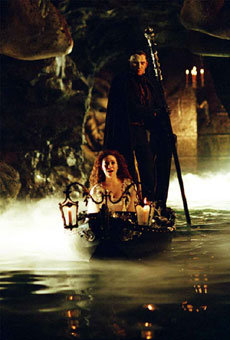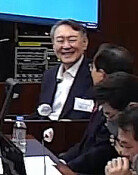The Musical in Screens Clothing
The Musical in Screens Clothing
Posted December. 08, 2004 23:12,

Andrew Lloyd Webber, the composer of the musical The Phantom of the Opera, co-produced music scripts of the movie version that is due to be released on December 8. This well shows why this film is closer to a musical as opposed to a movie. When this outstanding musical opened in 1986, Webber asked Joel Schumacher, who demonstrated excellent visual sense and musical appreciation through his movie Lost Boy (1987), to take on the role of director of the musical.
The movie The Phantom of the Opera has incorporated side stories such as the phantoms past into the original plot, but it is not so much a reinterpretation or reorganization of the musical as faithful restoration. The only differences from the musical would be that the ticket price is greatly reduced from around 120,000 won (seat R) to a mere 7,000 won (in Seoul), and you need to sit through two hours and 26 minutes without intercessions.
Christine Daae, who becomes a famous opera star with her fantastic voice from a no-name singer, is drawn to the music-genius Phantom, who leads her to his underground lair. Running away from the underground world after finding out the secret of the Phantom, whose face is half hidden under the mask, she falls in love with a young and attractive chief patron of the Opera Raoul. The Phantom, who had been watching their love with jealousy and anger, vows for vengeance.
As important as the story of the movie is the camera work. The photography is the absolute key to shifting the private and three-dimensional experience of watching the musical to a two-dimensional and duplicated space called the screen. This movie does not divide a scene into several cuts but employs a filming technique of following the scene from top to bottom in a flow, and thus successfully bringing the extensity of the opera stage and the underground world to spectators minds. On the other hand, the gorgeous opera performance scene is reproduced in short cuts to create intense spectacles and lively movements.
The movie measures up to its name just by the fact that you get to listen to the renowned repertoires of the original musical. Nonetheless, the film unexpectedly gives the sense of stillness, given the $100 million production cost (some 100 billion won) that has been injected in the luxurious setting, costumes, and the long list of the cast. This may be the fate of the film that faithfully follows the musicals grammar and tempo by concentrating the sound in songs to the extent of even minimizing the walking sounds rather than focusing on the films dynamics and the plot.
The same can be said about some scenes famous for creative stage settings in the musical such as the mighty chandelier crashing to the stage floor or the Phantoms ship calmly sailing along the underground world (This scene creates optical illusion: The ship appears to stay still while the torches on the sides seem to proceed). These scenes are overshadowed by the speedy development of the story in this movie version. Unlike musical films such as Moulin Rouge and Chicago, this film unfolds the story almost without lines but solely depending on songs.
The cast are Emmy Rossum (The Day After Tomorrow) for Christine, Gerard Butler (Lara Croft: Tomb Raider The Cradle of Life) for the Phantom, and Patrick Wilson (Angels in America) for Raoul. Though they are new faces compared to the recognition of the movie, they are all young, romantic, attractive, and what is more, excel at singing. It is just that Rossums facial expressions seem to be somewhat monotonous. The mole below her right eye is also troubling. For audiences over 12.
Seung-Jae Lee sjda@donga.com




![두쫀쿠가 뭐라고…영하 8도에 아이들 1시간 줄세운 어린이집 [e글e글]](https://dimg.donga.com/c/138/175/90/1/wps/NEWS/IMAGE/2026/01/09/133126969.3.jpg)
![지하철 타고 가는 북한산성…외국인도 반한 ‘K등산 맛집’[전승훈 기자의 아트로드]](https://dimg.donga.com/c/138/175/90/1/wps/NEWS/IMAGE/2026/01/10/133120824.1.jpg)

